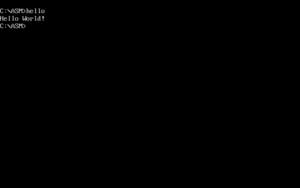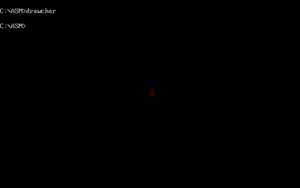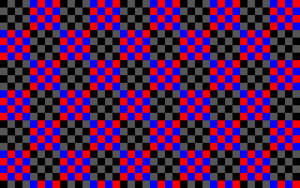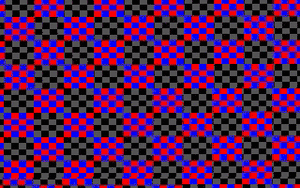Output
Contents
Outputting to the screen
First, be aware of the MSDOS memory layout
Outputting in Textmode (80x25)
Hello World / High Level function
Here's an obligatory "Hello World" program in text mode, using a "high level" MS-DOS function. With a small optimization already included (using XCHG BP,AX instead of MOV AH,09h), this snippet is 20 bytes in size.
org 100h ; we start at CS:100h
xchg bp,ax ; already a trick, puts 09h into AH
mov dx,text ; DX expects the adress of a $ terminated string
int 21h ; call the DOS function (AH = 09h)
ret ; quit
text:
db 'Hello World!$'
Low level access
The following three snippets showcase how to draw a red smiley in three different ways. All example snippets are meant to be standalone programs, starting with the first instruction and nothing before it. The target coordinate (40,12) is about the middle of the screen. We need a multiplier 2 since one char needs two bytes in memory (char and color is a byte each). The high byte 0x04 means red (4) on black (0) while the 0x01 is the first ASCII char - a smiley.
push 0xb800
pop ds
mov bx,(80*12+40)*2
mov ax, 0x0401
mov [bx],ax
ret
push 0xb800
pop es
mov di,(80*12+40)*2
mov ax, 0x0401
stosw
ret
push ss
push 0xb800
pop ss
mov sp,(80*12+40)*2
mov ax, 0x0401
push ax
pop ss
int 0x20
You might notice that the push <word> + pop seg_reg combination is always the same and occupies four bytes alltogether. If correct alignment is not important to you and you really just want any pointer to the screen, there is another way to get a valid one:
les bx,[si]
nop
stosb
That's also four bytes, but it already has the stosb opcode (for putting something onto the screen) integrated and even one slot free for another one-byte-instruction. It works because SI initially points to the start of our code, and stosb has the hexadecimal representation of 0AAh. After the first command, the segment register ES contains the value 0AA90h. If you repeatedly write something to the screen with stosb you will eventually reach the 0B800h segment and chars will appear on the screen. With a careful selection of the free one-byte-opcode you can also reintroduce some alignment. This works also with the stosw opcode 0ABh.
Alternative high level functions
Besides the direct way of accessing memory there are also other ways of bringing char to the screen (f.e)
Outputting in mode 13h (320x200)
Basic pixel output
The videomemory for mode 13h is located at segment 0xA000, so you need to assign this value to a segment register. Also, after the start of your program you are normally still in textmode, so you need to switch to the videomode. The following snippet does both:
mov al,0x13
int 0x10 ; AH = 0 means : set video mode to AL = 0x13 (320 x 200 pixels in 256 colors)
push 0xA000 ; put value on the stack
pop es ; pop the top stack value into segment register ES
You're free to use any of the segment register / opcode combinations to write to the screen
-
ES(stosb) -
DS(mov) -
SS(push)
Let's add some code that actually draws something on the screen, the following program occupies 23 bytes and draws a fullscreen XOR texture
mov al,0x13
int 0x10
push 0xa000
pop es
X: cwd ; "clear" DX (if AH < 0x7F)
mov ax,di ; get screen position into AX
mov bx,320 ; get screen width into BX
div bx ; divide, to get row and column
xor ax,dx ; the famous XOR pattern
and al,32+8 ; a more interesting variation of it
stosb ; finally, draw to the screen
jmp short X ; rinse and repeat
Note that there is a different way of preparing the segment register, instead of :
push 0xa000
pop es
you can also do :
mov ah,0xA0
mov es,ax
both variations occupy 4 bytes, but the latter is executable on processor architectures where push <word> is not available.
Alternative way of pixel plotting and optimization
Now let's optimize on the snippet. First, we can adapt the "LES" trick from the textmode section. We just exchange
push 0xa000
pop es
with:
les bx,[bx]
to save two bytes. This works because BX is 0x0000 at start and thus, accesses the region before our code, which is called Program Segment Prefix. The two bytes that are put into the segment register ES are bytes 2 and 3 = "Segment of the first byte beyond the memory allocated to the program" which is usually 0x9FFF. That is just off by one to our desired 0xA000. Unfortunately that means a 16 pixel offset, so if screen alignment means something to you, you can't use this optimization. Also, said two bytes are not always 0x9FFF; for example, if resident programs are above the "memory allocated to the program" (FreeDos), their content is overwritten if we take their base as our video memory base.
Second, we can use an alternative way of putting pixels to the screen, subfunction AH = 0x0C of int 0x10. Also, instead of constructing row and column from the screen pointer, we can use some interesting properties of the screenwidth regarding logical operations. This results in the following 16 byte program:
cwd ; "clear" DX for perfect alignment
mov al,0x13
X: int 0x10 ; set video mode AND draw pixel
inc cx ; increment column
mov ax,cx ; get column in AH
xor al,ah ; the famous XOR pattern
mov ah,0x0C ; set subfunction "set pixel" for int 0x10
and al,32+8 ; a more interesting variation of it
jmp short X ; rinse and repeat
The first optimization is the double usage of the same "int 0x10" as setting the videomode and drawing the pixel. The subfunction AH = 0x0C expects row and column in DX and CX. Since the screenwidth is 320, which is 5 * 64, we can ignore the row and just works with the column, if we use logical operations and just use bit 0-6 of the result. The subfunction AH = 0x0C allows for unbounded column values in CX (up to 65535) and correctly "wraps" it internally without an error.
The major drawback of the "subfunction AH = 0x0C" approach is performance loss. While DosBox and many emulators perform just fine, real hardware will draw much much slower based on the Video BIOS.
Basic animation and user interaction
Now let's add the convenient check for the ESC key and also add a simple animation. The DI register is used as frame counter and incremented after the pixel counter CX ran through all 65536 values via LOOP. This frame counter is then added to the column. The resulting program is now 25 bytes in size :
cwd ; "clear" DX for perfect alignment
mov al,0x13
X: int 0x10 ; set video mode AND draw pixel
mov ax,cx ; get column in AH
add ax,di ; offset by framecounter
xor al,ah ; the famous XOR pattern
and al,32+8 ; a more interesting variation of it
mov ah,0x0C ; set subfunction "set pixel" for int 0x10
loop X ; loop 65536 times
inc di ; increment framecounter
in al,0x60 ; check keyboard ...
dec al ; ... for ESC
jnz X ; rinse and repeat
ret ; quit program
( ↑ This example is the blueprint in the FPU Basics Section.)
Using Custom Colors
Shades of Hue within the Default VGA palette
You might have noticed there is a bit of structure to the default VGA Palette, which you can exploit for some interesting results. Looking at the pallete there is a rainbow of different hue values that start at index 32 that are repeated in a slightly different luma seperated by 72 indices. If you are okay with limiting the amount of shades you need, you can get a small colorramp for all kinds of hue values by simply calculating your color-index like this:
color=((shade%3)*72)+32+huevalue
For an example of how this looks for all kinds of hue values, see Popcast by Hellmood/Desire.
Setting a Custom Palette
Sometimes, when the Default VGA Palette doesn't quite match the look you are looking for, it can be useful to set your own palette using the VGA registers, the basic setup loop looks like this:
palloop:
mov ax,cx
mov dx,0x3c8
out dx,al ; select palette color
inc dx
out dx,al ; write red value (0..63)
out dx,al ; write green value (0..63)
out dx,al ; write blue value (0..63)
loop palloop
The above code sets a simple grayscale palette, assumes CX Register to be at 0) and is compatible with all DOS platforms.
In some cases you can ommit the mov dx,0x3c8, out dx,al, inc dx and directly access the data register by just using mov dx,0x3c9 instead.
To get more interesting colors than just grayscale, you can alter the value of the AL register in between setting the red, green and blue values. For example by shifting, adding, substracting or performing logical operations. Just get creative and check if the result is sufficient for your usecase.
TomCat will show the most common color palettes grouped by functionality. Check his article: Colors (in tiny intros)



